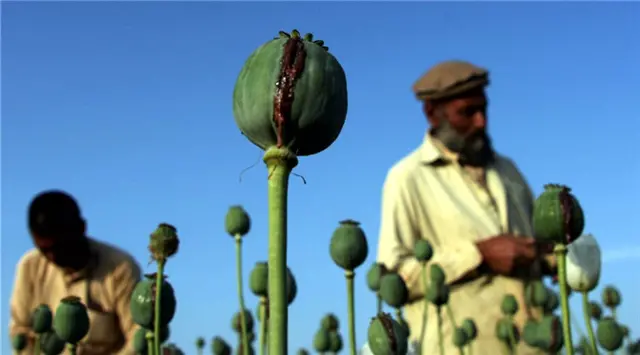With an AK-47 assault rifle slung casually over his shoulder, Allah Mohammad, while slashing an opium bulb with a vicious looking knife and extracting its milky nectar that seeps from the cuts, said that he thanks the chaos and ongoing militancy in Afghanistan as it allows him to grow poppies on his farm in the Ghorak district of the southern Kandahar province.
"The police in government-controlled areas don't allow the farmers to grow poppies, but in some areas like the Ghorak district where the government only has a loose grip, the farmers can cultivate poppies and run the easy, profitable business," Mohammad said recently.
"Planting opium poppies and converting the plant's nectar to heroin is a profitable business for the villagers here in Ghorak where government forces barely exist," the farmer said, adding that the farmers have gained experience in growing poppies and that is why they can earn three to four times more over the past few years than in the last decade.
Kandahar and the neighboring Helmand, Zabul and Uruzgan provinces where anti-government militants including the Taliban are active, are areas responsible for producing a major part of all opium poppies harvested in Afghanistan annually.
According to Mohammad, parts of the Ghorak, Miwand and Khakriz districts where security forces' presence is slim are suitable places for the farmers to grow poppies. Meanwhile, officials in Kandahar's provincial capital of Kandahar city have claimed that poppy cultivation has been eradicated in government-controlled areas.
Nevertheless, the officials have admitted that in spite of the government's tireless war on drugs, people in unregulated areas take advantage of the situation to grow poppy fields to fuel the lucrative heroin trade.
The growing of poppies and their byproducts have been on a constant rise in Afghanistan since the collapse of the Taliban regime in late 2001, and a survey conducted by the Afghan Ministry for Counter-Narcotics and the United Nations Office on Drugs and Crime, released in October, revealed a 43 percent increase in the amount of drugs being harvested, compared to a year earlier.
The estimated opium production in 2016, according to the survey, was 4,800 tons, compared to 3,300 tons in 2015 and, similarly, the land used to cultivate poppies in the current year had increased 10 percent to 201,000 hectares compared to last year.
The majority of the opium, the raw material used in the manufacturing of heroin, according to officials, has been produced in the troubled provinces where Taliban militants are active.
A Taliban fighter on one poppy field, who spoke on condition of anonymity, confessed his support for growing poppies and producing the drug, saying, "Although growing poppies and producing heroin is forbidden in Islam, poverty has forced us Taliban to support poppy growing."
"It is a source of income for the farmers as well as for the Taliban, as the Taliban collect one kilogram from every 10 kg of opium produced by the farmers as 'Ashar' (an Islamic principle to collect one-tenth from legal crop yields to help the Islamic government and poor families) to support Jihad (holy war) in Afghanistan," the Taliban fighter said.
 简体中文
简体中文

